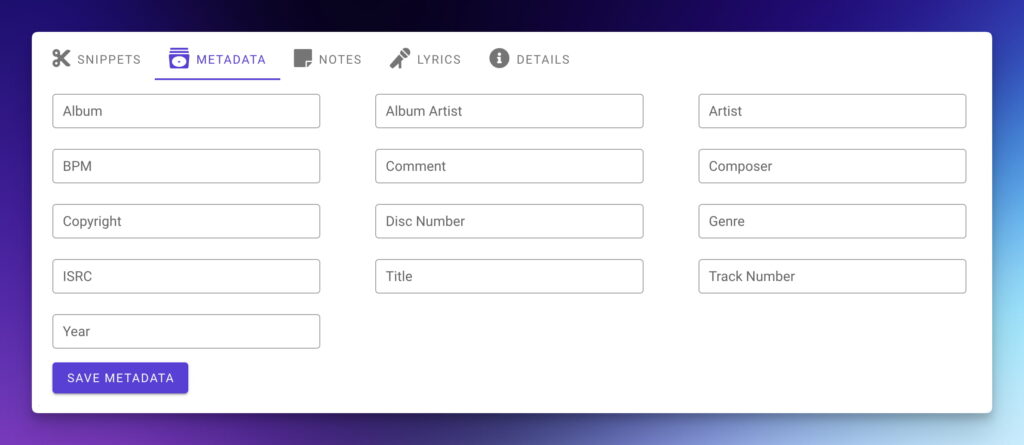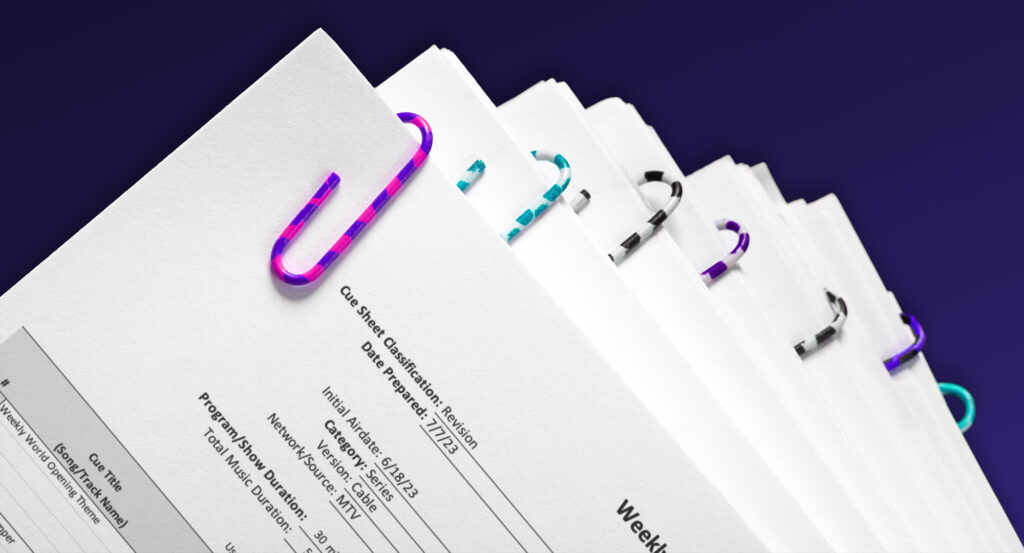Music licensing can be a lucrative way to make money from your music. By licensing your music for use in film, TV, movie trailers, and advertising, you can create income on the front end from sync licensing fees and on the back end from performance royalties.
As a music producer, composer, or songwriter, you know how important it is to get paid for your hard work. But did you know that cue sheets are an important step in getting paid royalties after the initial licensing deal is done?
So what exactly is a cue sheet, what’s it used for, and who handles submitting it? Read on to learn everything you need to know about cue sheets!
Cue sheets are an important step in getting paid royalties
What is a music cue sheet?
A cue sheet is a list of all the music used in a film, television show, video game, or other production. It includes essential information such as the cue’s title, the composer/writer, the publisher, the length of the cue, and where it appears in the production. Cue sheets are used by performing rights organizations (PROs) such as ASCAP, BMI, and SESAC in the United States or foreign PROs to track the use of music in productions and pay the composers/writers and publishers accordingly.
For composers and publishers, it is important to familiarize yourself with music cue sheets and how they can benefit you. If you are a film or television producer, it is equally important to understand how music cue sheets work and how they can help you protect the rights to the music you use.
If you are curious about what a cue sheet looks like, ASCAP and BMI have examples of cue sheets on their websites.
Who should fill out cue sheets?
Filling out and submitting a cue sheet is a critical part of getting paid performance royalties for your music, but it’s not something you will usually handle yourself. Instead, most professional production companies will have someone responsible for creating and filling out the required forms and submitting them to the appropriate PRO. The PRO will then use the cue sheet to track when your music is played and pay you (the rights holder) any performance royalties you’re owed.
Cue sheets are easy and free to create and fill out (they won’t cost the production house anything extra!), and they’re the only way PROs can keep track of when your music is used in public broadcast projects. Plus, every distributor requires a music cue sheet as a deliverable, so it’s in everyone’s best interest to make sure they are submitted correctly and on time.
However, some smaller production houses or independent filmmakers may not know how to create and submit cue sheets. If you find yourself in this situation, it may fall on you to try and educate them about the process.
To avoid dealing with missing cue sheets in the future, you can include a clause in your sync license agreement that requires the production company to submit a cue sheet. You should also request a copy of the completed cue sheet to verify that the titles, timings, composer/publisher splits, and other information are correct.
Still having trouble getting a production house or filmmaker to submit your cue sheet? Reach out to your PRO, and they’ll be happy to help you submit a cue sheet.
Cue sheets are easy and free to create and fill out
Four tips to help ensure that your music is ready for licensing and cue sheets are completed
1. Register your music with a performance rights organization
If you want your music to be considered for cue sheets, you must register it with a PRO such as ASCAP, BMI, or SESAC.
As a songwriter, composer, or music publisher, you can choose which PRO to affiliate with. There are a few things to consider when selecting a PRO:
- The type of music the PRO focuses on
- The size of the network of affiliated writers and publishers they work with
- How the PRO distributes royalties
Once you’ve considered all of these factors, you should have a good idea of which PRO is right for you.
2. Be upfront about sharing publishing/writers rights
Let the editor or producer know upfront if you’re submitting or pitching music that you’ve co-written with someone else. This will help them understand what kind of splits will need to be made and can avoid any potential confusion or delays further down the line.
3. Make sure your contact and rights information is easily accessible
When you or your representative submits music to an editor or music supervisor, be sure to embed all the relevant information in the track metadata.
In addition to basic info about the track (like artist name, title, genre, etc.), don’t forget to add contact and rights details in the Comments section of your metadata. Being thorough is always appreciated — it will help the producer do their job and avoid unnecessary confusion or delays.
Your metadata should include the following:
- Your full legal name, contact information, and PRO affiliation
- The rights you control, including percentages
- Who to contact for rights clearance
- Names and percentages owned for additional rights holders
Being thorough is always appreciated
For example, the Comments section of your metadata might look like this:
Publishing: 50% Publishing House / 50% J. Composer Music
For publishing clearance, contact: abhi@email.com (Publishing House) / jc@email.com (J. Composer Music)
Master: 50% Cool Label LLC / 50% Music Clearance Co.
For master clearance, contact: henrik@email.com (Cool Label LLC) / adrian@email.com (Music Clearance Co.)
Or if you own and control 100% of publishing & master you can put:
One-stop clearance, contact: jc@email.com

4. Check in with networks/production companies
Once you’ve submitted your music, it’s always a good idea to follow up with the relevant networks or production companies. You should confirm who is creating the cue sheet and that you (the writer) will have the opportunity to verify that it’s accurate and filed correctly. This final step will help avoid delays in receiving the proper performance royalties for your compositions.
Wrap up
As an artist, cue sheets may not be part of your daily duties, but understanding how they work is critical to getting paid for your creative work when licensing your music. By taking the time to register with a PRO, keeping your metadata updated, and confirming cue sheet submissions, you’ll be setting yourself up for success and (hopefully!) a growing stream of ”mailbox money.”
If you’d like to learn more about how a PRO works behind the scenes, check out this great article from ASCAP » https://www.ascap.com/help/royalties-and-payment/payment
Check out the rest of our music licensing series:
How sync licensing works
Choosing the right vehicle for licensing your music
4 things composers can do to get paid what they’re owed
Want to learn more about sync licensing?
Join our email list to get a copy of our guide to PREPPING YOUR TRACKS FOR SUBMISSION—sign up below.




